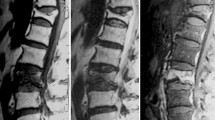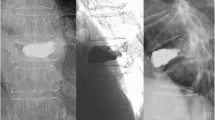Abstract
Purpose
To evaluate relationships between biochemical markers of bone turnover, bone mineral density, and new compression fractures following vertebroplasty.
Methods
Initially, we enrolled 30 consecutive patients with vertebral compression fractures caused by osteoporosis. Twenty-three of the 30 patients visited our hospital for follow-up examinations for more than 4 weeks after vertebroplasty. The patients were divided into two groups: patients with new fractures (group F) and patients with no new fractures (group N). We analyzed differences in the following parameters between these two groups: serum bone alkaline phosphatase, urinary crosslinked N-telopeptide of type I collagen, urinary deoxypyridinoline, and bone mineral density. Next, the patients were divided into another two groups: patients with higher risk (group H: urinary crosslinked N-telopeptide of type I collagen >54.3 nmol BCE/mmol Cr or urinary deoxypyridinoline >7.6 nmol/mmol Cr, and serum bone alkaline phosphatase <29.0 U/l) and patients with lower risk (group L). We analyzed the difference in the rate of new fractures between these two groups.
Results
We identified 9 new fractures in 7 patients. There were no significant differences between groups F and N. We identified 5 new fractures in 3 of the 4 patients in group H, and 4 new fractures in 4 of the 19 patients in group L. There was a significant difference in the rate of new fractures between groups H and L.
Conclusions
A combination of high levels of bone resorption markers and normal levels of bone formation markers may be associated with increased risk of new recurrent fractures after percutaneous vertebroplasty.
Similar content being viewed by others
References
Cotten A, Boutry N, Cortet B et al. (1998) Percutaneous vertebroplasty: State of the art. Radiographics 18:311–323
Peh WC, Gilula LA, Peck DD (2002) Percutaneous vertebroplasty for severe osteoporotic vertebral body compression fractures. Radiology 223:121–126
Kallmes DF, Jensen ME (2003) Percutaneous vertebroplasty. Radiology 229:27–36
Grados F, Depriester C, Cayrolle G et al. (2000) Long-term observations of vertebral osteoporotic fractures treated by percutaneous vertebroplasty. Rheumatology (Oxford) 39:1410–1414
Uppin AA, Hirsch JA, Centenera LV et al. (2003) Occurrence of new vertebral body fracture after percutaneous vertebroplasty in patients with osteoporosis. Radiology 226:119–124
Lin EP, Ekholm S, Hiwatashi A et al. (2004) Vertebroplasty: Cement leakage into the disc increases the risk of new fracture of adjacent vertebral body. AJNR Am J Neuroradiol 25:175–180
Komemushi A, Tanigawa N, Kariya S et al. (2006) Percutaneous vertebroplasty for osteoporotic compression fracture: Multivariate study of predictors of new vertebral body fracture. Cardiovasc Intervent Radiol 29:580–585
Nishizawa Y, Nakamura T, Ohta H et al. (2005) Guidelines for the use of biochemical markers of bone turnover in osteoporosis (2004). J Bone Miner Metab 23:97–104
Weinstein RS (2000) True strength. J Bone Miner Res 15:621–625
Chesnut CH 3rd, Rosen CJ, Bone Quality Discussion Group (2001) Reconsidering the effects of antiresorptive therapies in reducing osteoporotic fracture. J Bone Miner Res 16:2163–2172
Tanigawa N, Komemushi A, Kariya S et al. (2005) Intraosseous venography with carbon dioxide contrast agent in percutaneous vertebroplasty. AJR Am J Roentgenol 184:567–570
Leibold RA, Gilula LA (2002) Sterilization of barium for vertebroplasty: An effective, reliable, and inexpensive method to sterilize powders for surgical procedures. AJR Am J Roentgenol 179:198–200
Maehara M, Tanigawa N, Ikeda K et al. (2006) Gadolinium-enhanced magnetic resonance imaging after percutaneous vertebroplasty does not improve the short-term prediction of new compression fractures. Acta Radiol 47:817–822
Lindsay R, Silverman SL, Cooper C et al. (2001) Risk of new vertebral fracture in the year following a fracture. JAMA 285:320–323
Delmas PD, Ensrud KE, Adachi JD et al. (2002) Multiple Outcomes of Raloxifene Evaluation Investigators. Efficacy of raloxifene on vertebral fracture risk reduction in postmenopausal women with osteoporosis: Four-year results from a randomized clinical trial. J Clin Endocrinol Metab 87:3609–3617
Hulme PA, Krebs J, Ferguson SJ et al. (2006) Vertebroplasty and kyphoplasty: A systematic review of 69 clinical studies. Spine 31:1983–2001
Cummings SR, Karpf DB, Harris F et al. (2002) Improvement in spine bone density and reduction in risk of vertebral fractures during treatment with antiresorptive drugs. Am J Med 112:281–289
Author information
Authors and Affiliations
Corresponding author
Rights and permissions
About this article
Cite this article
Komemushi, A., Tanigawa, N., Kariya, S. et al. Biochemical Markers of Bone Turnover in Percutaneous Vertebroplasty for Osteoporotic Compression Fracture. Cardiovasc Intervent Radiol 31, 332–335 (2008). https://doi.org/10.1007/s00270-007-9246-8
Received:
Revised:
Accepted:
Published:
Issue Date:
DOI: https://doi.org/10.1007/s00270-007-9246-8




